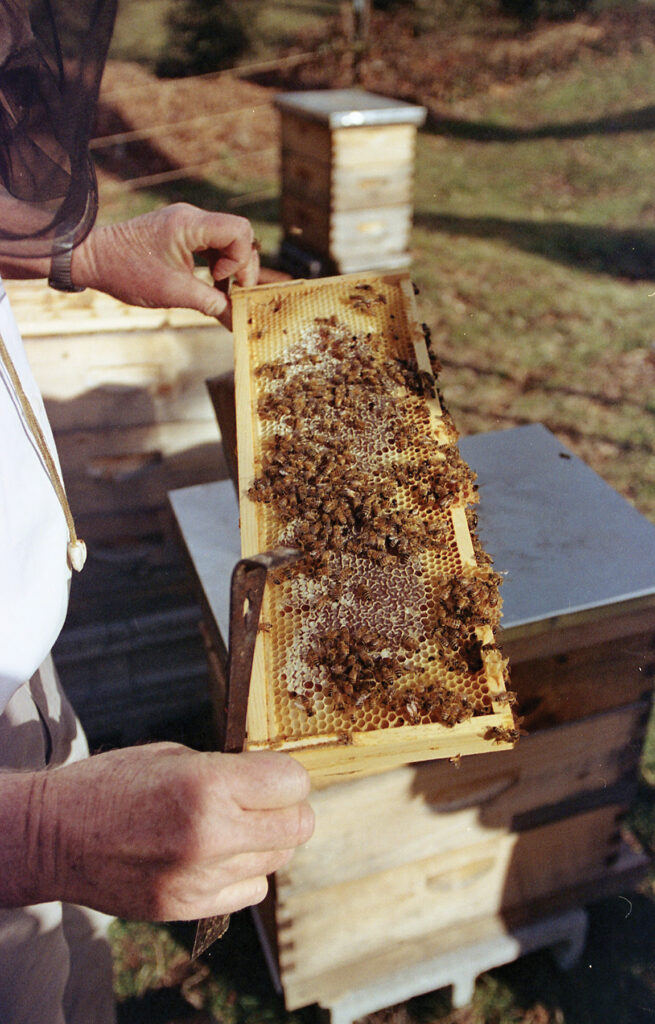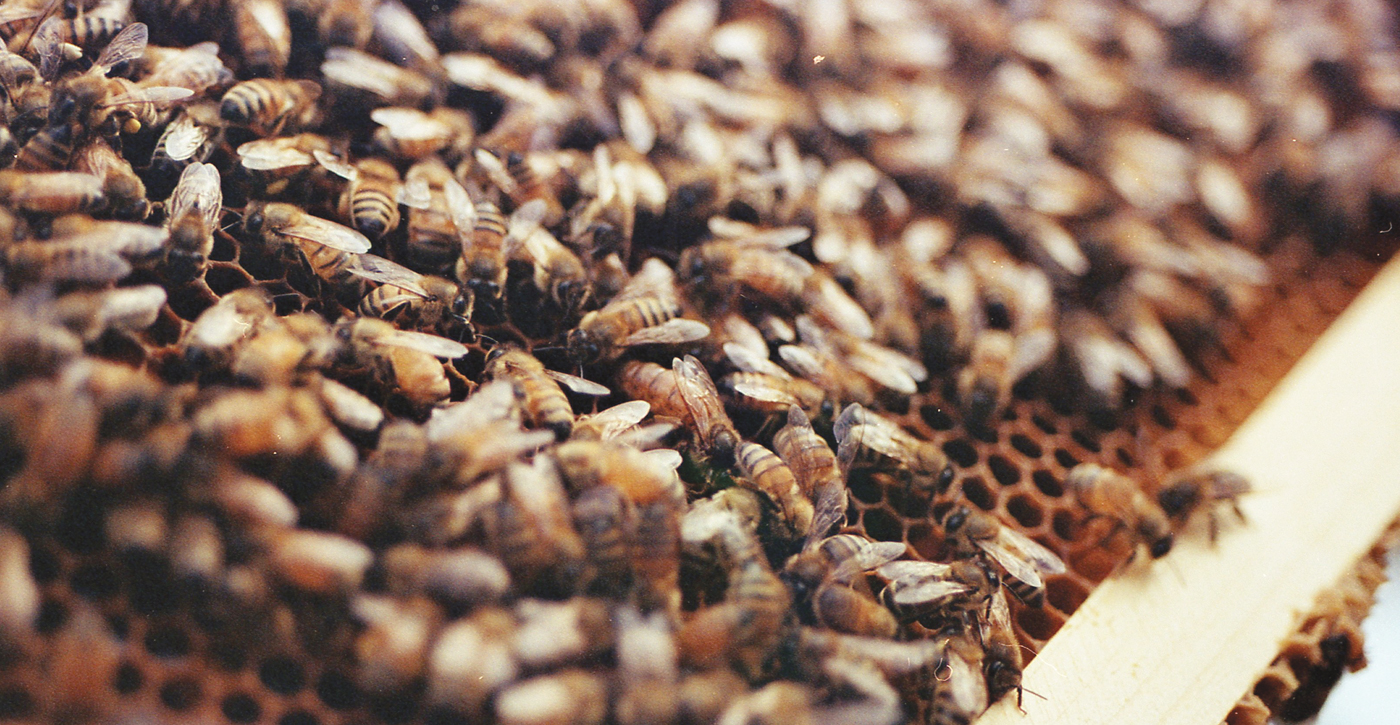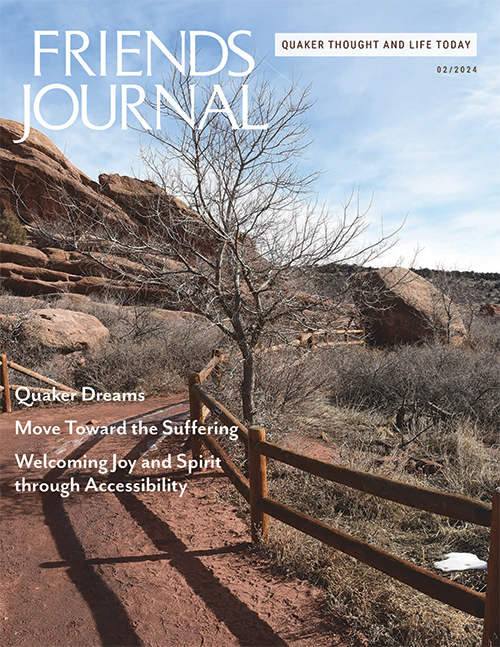Of Friends, Bees, and Virtual Meetings
When I enter the apiary, I carry my smoker, hive tool, and usually a veil, for though I no longer mind stings, I do not like getting stung on my face. I crack the first hive and wave the smoker over the top of the crowded frames, like a priest swinging the censer, and then I pull frames one by one, checking the state of the colony: whether they are in a good mood or not, whether the queen is laying, whether the colony is growing or contracting, whether they have enough food.
In fact, now that I think of it, the ritual of entering the hive begins a little earlier when I am preparing to visit the bees. There is the matter of checking the weather, for it is best to visit on a warm, sunny day. And I consider my intentions: Am I simply seeing to their health, or do I want to add or remove honey supers, or should I treat the hive for varroa mites or other pests that afflict so many bees these days?
Depending on the answers to these questions, I need different equipment. So I go down to the basement, which serves as my honey house, and gather whatever I need. The basement sits above ground, so I can go directly out the back to the hives. I use an old recycling bin to carry it all.
Then there’s the matter of lighting the smoker. (I use aspen wood shavings that I get at a pet store.) It’s important that it be well-lit and stay lit, so I test it by working the bellows vigorously until they belch forth a great cloud of white smoke, like an old-time locomotive. The smoke smells like a campfire.
Smoker lit, veil on, tool in hand, I step over to the apiary, turn off the bear fence (around here in the Blue Ridge Mountains, without electric fences, black bears would ravage the hives), and enter. Then I go from hive to hive; taking care of business; looking at bees; and, yes, even talking to them.
As I do all this, a shift occurs. My mind grows quiet. My heart slows. I become more focused than usual, aware of myself and what is near. The bees, I have learned, do not like a distracted beekeeper. I feel the way I feel when I am sitting in meeting for worship.
Keeping bees is not simply a matter of taking their honey. We beekeepers have a reciprocal relationship with our bees. And bees are remarkably attentive. They know what the beekeeper does and what the beekeeper smells like. There is even science to indicate that bees recognize individual people by sight. Beekeepers also come to know the personalities of our different hives. We know the behaviors, the sounds, and even the smells of healthy and sick, strong and weak, peaceful and agitated colonies.
Being together, we come in time to know each other.
Beekeepers also come to know the personalities of our different hives. We know the behaviors, the sounds, and even the smells of healthy and sick, strong and weak, peaceful and agitated colonies. Being together, we come in time to know each other.
I have come to see my work with bees as a form of worship. Writing about bees is an opportunity to reflect on what worship means to me, and it has helped me to explain why I much prefer in-person worship over worshiping on Zoom or other virtual platforms. Our meeting, like many others today, is partly on Zoom and partly in person, and there’s great and understandable interest in unifying us, but there is also resistance from some, including me, to the use of technology in meeting for worship.
I’m not alone in thinking that we encounter the Divine when we work with bees—not that they are more divine than anything else but that they are a window into everything else. I suspect that given the nature of the universe, we encounter divinity in infinite ways: anywhere, anytime, anyhow. But the idea of doing so with bees is many thousands of years old. Some of the earliest paintings in existence depict honey gatherers on rope ladders foraging honeycombs high up rocky cliffs. The care they took to paint these scenes so long ago gives them the aura of holiness.
Much later, apiaries were attached to monasteries and churches, not so much for honey but for the beeswax for candles: the bees delivered light! The old monastic tradition of hesychasm also comes to mind. Hesychastic worship, or prayer, is continuous and quotidian: one prays in the sanctuary and also while one sweeps the floor, washes the dishes, makes the bed, sows the wheat, keeps the bees.
The idea that life itself is worship appeals to me. It seems Quakerly: why should worship be one place and not another? This is related to the more fundamental question of why the Light should be in one person and not another. We are called to see the Light in others always, not just on First Day in the meetinghouse. We are called to witness the Divine in everything. Surely that act is a form of worship.

My father was a beekeeper and one of the most Spirit-led individuals I’ve ever known. For much of my youth, he was a Presbyterian minister (though he descended from old Quaker families in upstate New York), but even after he left the church for matters largely theological, he continued to regard the world, all of nature, as holy. I used to help him with his bees. When he died ten years ago, I carried on his beekeeping, and bees became a sort of conduit through which I accessed nature and, I like to think, divinity.
Beekeeping, of course, is associated in my mind with memories of my father, and my father is associated in my mind with notions I have about God or Nature or Spirit, in any form. Worship is not a simple thing. It is hard to pin down exactly what it is, let alone what it isn’t. One relies on what one already knows, and for me that begins with my parents and those early times in sanctuaries with and without pews.
What I learned from my father and mother, attending Presbyterian churches and Quaker meetinghouses, and walking in the woods and visiting beehives, was that there is something important about doing all of this fully present with our bodies: about showing up in person, about worship as embodied encounter. One cannot sweep a floor virtually; one cannot keep bees virtually; one cannot pray virtually . . . not really. One has to do it with one’s whole body and mind.
We can pray anywhere, and I suppose that means we can worship anywhere, even on Zoom. But while it may feel like I’m gathering with others online, it is a paler, thinner form of gathering than what I experience in person with others. I feel this way for the same reasons that viewing a forest via a photograph in National Geographic magazine is a paler, thinner experience than visiting it in person.
I have Jewish friends (and Friends) who remind me that Orthodox Jews may not use a car or electronic device on the Sabbath. One reason for this, among others, is that the prohibition of technology holds the community near to one another: one must live close enough to one’s shul to walk there on the Sabbath, and that means people not only worship together in community but must also live together in community.
Now, I know that most of us have left behind the time when we were willing to set aside work, cars, computers, and light switches for the Sabbath. I am willing to drive and turn on a computer on First Day. But there is a kernel of an idea here that is worth keeping in mind. Worship is not simply an abstraction, or even what happens in a meetinghouse. It is a continuum of practices that involves bodies, minds, and spirits coming together, just as inspecting bees starts long before one cracks the lid on a beehive.
There is something about the physical act of rising from bed, preparing my body, eating and anticipating, then getting to the meetinghouse, greeting Norma or whoever is waiting at the door, finding a seat, shaking hands, nodding to others, smelling the smells of the room, seeing the light shine in through the windows, hearing the rush of the river outside, settling into silence, and waiting. . . . All of that and not any one thing in particular—not only the sitting in the silence—but all of that together is worship. At least for me it is.
Worship is not simply an abstraction, or even what happens in a meetinghouse. It is a continuum of practices that involves bodies, minds, and spirits coming together, just as inspecting bees starts long before one cracks the lid on a beehive.
I am a Friend and an anthropologist. I have spent much of my life, as many humans do, thinking about what it means to be human. I have not figured it out. We are too mysterious and complex and variable. But one principle my discipline has landed on is that in order to be truly ourselves, we must interact with other selves. In a strange alchemy, we must internalize them as we externalize ourselves, and as we are in turn internalized by others. To be our true selves, we must be or at least have been involved in interactions with others. In fact, to be ourselves we must, in a sense, be other selves, too.
Such exchanges are necessarily embodied. Despite what some think—particularly in the West—there is no split between mind and body. Our minds are our bodies, and our bodies are our minds. Meeting for worship starts with our bodies as we check in with our internal and external states. And our tradition involves doing this in the company of other bodies doing the same thing.
Yet we live in economic and technological times that promote the illusory mind–body divide. Social media, electronic gaming, artificial intelligence, and all sorts of other technological conveniences keep the metaverse at our fingertips. They market the allure of virtual life. They preach that our bodies don’t really matter, that we can (or will soon) do business together in a “meta” world.
All of that may in fact be our future. It certainly looks like a trend, but as Quakers, we have an obligation to step outside our society’s trends, norms, and expectations—just as we eventually stepped outside our society’s acceptance of slavery and war—and wonder whether such practices are wise, Spirit-led, humane, enlightened.
Yes, I know that some Friends cannot physically make it to meeting. That is the most common argument I hear for Zoom worship. It is not a new phenomenon. It did not begin with COVID. Friends (and members of other faiths) have wrestled since time immemorial with some Friends’ inability to attend worship. One of the distinctive features of our humanity is our care for those in need. How much more meaningful is showing up at each other’s doors and gathering those who cannot drive and bringing them in body and spirit to meeting? Or going in person to worship with them in their homes?
In many cases, it seems that the turn to Zoom is a turn to convenience, expedience, and efficiency. It began as a public health necessity. Now I fear that it is a too-easy acquiescence to the values promoted by the world’s tech giants. Don’t we lose something when we no longer do business with a person at a cash register? Don’t we lose something when we call an office and cannot speak to a person? Don’t we lose something when we buy on credit and do not pull bills from our wallet or trade goods for goods?
I know all too well that life is more complex these days, that a yearning for old exchanges is nostalgic and futile. Times have changed. I accept that.
But I also think that in these times we are called upon to wonder, to ask questions, to decide in the Light what sorts of change we can abide and what we cannot. We must decide for ourselves.
A Friend on Zoom recently associated Zoom and hybrid meeting with inclusivity—an open door—and suggested that those who resist the hybrid format were closing a door. The spirit here is right: keep the doors open, but the implication in this case is unfair. The door at our physical meetinghouse has remained open. Zoom Friends seem to want in-person Friends to consider hybridity: the inclusion of technology during worship, to welcome it in the spirit of inclusivity. I have spent a lot of time considering the question. But I have not felt much reciprocal consideration by Zoom Friends to return to meeting in person—where the door has remained open—or even to name the terms of such a return.
There has been little, if any, recognition of the ways technologies such as Zoom intrude on worship. I remember when meetings prohibited photography during worship, even at wedding ceremonies. As much as the impulse has been to unify Zoom and in-person worship, the effect of hybrid worship is divisive, at least for me. True, all of the passengers on a commercial airline are flying on the same plane, but first and coach classes take fundamentally different flights. They are not gathered together.
What does technology like Zoom do for worship? There seems to be an assumption that it helps, or aids. But even its advocates suggest it is a compromise, a next-best thing: better than the utter absence of contact with each other but less than preferred. It seems to be a substitute. When does the stopgap end and the return begin? Are the alternatives—visiting shut-in Friends at their homes for worship, or gathering them up and bringing them to the meetinghouse—too inconvenient or impractical? And those who live far away, why do they not worship in person with nearby Friends? Divisions in meetings are as old as the Society of Friends: they are embedded in the difference between monthly and yearly meetings. We now have the technology to worship year-round as one congregation with yearly meeting, with the general conference, with Friends all over the world. Why don’t we do that? Because we worship with those at hand.
What if the inconveniences of carrying ourselves as well as other Friends across town or county were an integral part of the worship experience? What if one of the crucial factors of Spirit is our actually gathering together in the presence of one another, as a prayerful minyan, as it is known in the Jewish tradition: a practice that insists first on community with each other as a means to our communion with God. Have we really reflected on the effects of technology on our communities?
There is no virtual beekeeping. There is, I venture, no virtual community. Not really. There is, as there has always been, a community in flesh and spirit. It would be reassuring if I sensed that the question of virtuality was being threshed with consideration of its effect on gathered worship and our encounter with God.
Now I’m going to gather up my tools and step back out into the bee yard, risk the stings and anticipate the sweetness of honey, and hope that the bees accept me in person into their company.





John, thank you for your reflections on bees and the power of presence that in-person worship offers. I agree that “being together we come to know each other”. We create and renew the meeting community each time we come together in the same room.
Our meeting has kept the hybrid form for the main meeting. We have distant and shutin friends who can only participate that way. I think that contrary to what the author says, Zoom friends have given consideration to attending in person, and that he underestimates the difficulty. We do what we can to help.